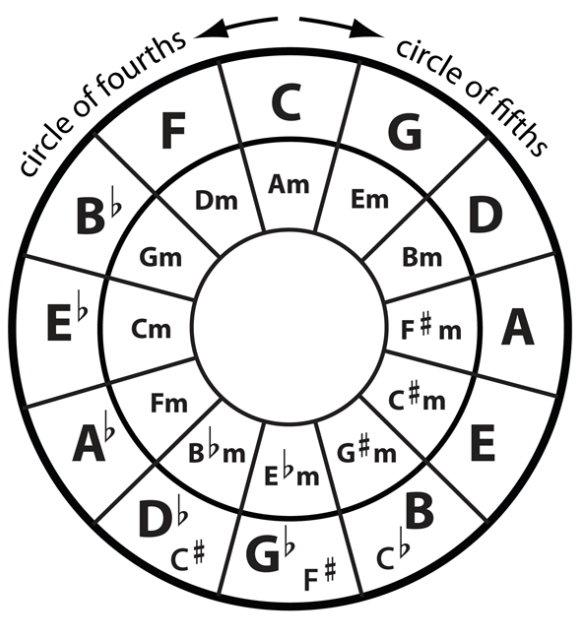In today’s post, we’ll be learning about cyclical chord progressions.
Cyclical chord progressions are among the most common and strongest chord progressions in music.
A chord progression is the movement of chords [from one degree of the scale to another].
Determining what comes next in chord progressions can be challenging. However, with the knowledge of cyclical chord progressions, not only will you know what comes before a chord, you’ll also know what comes after it.
The Unpredictability Of Chord Progressions
When listening to chord progressions, all attention should be given to the movement of the root.
By now, you’re already familiar with the key of C major, where the C major triad:
…is chord 1. We can’t create dynamic music, however, by remaining on chord 1 forever.
To make music, chord 1 will have to progress elsewhere and can even move to three or more other degrees of the scale before returning back to chord 1.
I said that to say that the progression or movement of chords (aka – “chord progressions”) makes music dynamic. Conversely, chord progressions can make music unpredictable.
I’ve heard questions of this sort literally hundreds of times: “After playing Eb major seventh, how did you know that the next chord to play is C minor seventh?”
Chord progressions help us to progress elsewhere but they don’t necessarily tell us where. For example, after playing chord 1:
…in the key of C major, where do you think I’m likely to move to?
Silence?
Chord 1 can move to the following chords:
Chord 2
Chord 3
Chord 4
Chord 5
Chord 6
Chord 7
…That’s six options put together, not including tones/chords that are not a part of the major scale.
Most songs start on chord 1, no doubt, but knowing where the chord will progress or move is usually the challenge for beginners.
At this point, someone is asking “Is there something I need to know that can make it possible for me to recognize and even predict where chords are progressing to?”
Basic Concept Of The Cyclical Progressions
Chord movements that are based on a particular interval are called cyclical progressions. In this post, we’re exploring progressions with root movements based on an interval of fourths.
Once again, here’s our cycle (or circle) of fourths:

If you follow this cycle in a counter-clockwise direction, it represents the movement of the root of chords in intervals of fourths.
Using this cycle, it’s easy to see the root move from C to F:
…F to Bb:
…Bb to Eb:
…following this musical clock in the counter-clockwise direction.
While the organizing of notes on the cycle of fourths are based on perfect fourth intervals, root progressions can also move using the augmented fourth interval.
It’s possible to have C:
…move to F#:
It’s also possible to have F:
…move to B:
I’ll throw more light on this in the next segment of this post.
Attention: No doubt, root progressions can move in any quality of fourth – whether perfect or augmented, however, it’s more common to see them move in the perfect fourth intervals.
“Dear Musician, There’s Something You Need To See”
Before we look at the cyclic progression, I want to show you something in the key of Ab. Here’s the Ab major scale for reference:
Ab (1)
Bb (2)
C (3)
Db (4)
Eb (5)
F (6)
G (7)
Using the music clock in the counter-clockwise direction:

…the seven tones of the Ab major scale can be rearranged in fourth intervals starting from C. Check it out below:
C to F:
…a perfect fourth.
F to Bb:
…a perfect fourth.
Bb to Eb:
…a perfect fourth.
Eb to Ab:
…a perfect fourth.
Ab to Db:
…a perfect fourth.
Db to G:
….an augmented fourth.
G to C:
…a perfect fourth.
Attention: When the tones of a major scale are arranged in intervals of fourths, it’s basically perfect fourth intervals all the way, save for one augmented fourth interval (aka – “the devil in music”) between the fourth and seventh degrees of the scale. Find out what happens when we cast out the devil in music.
If we rearrange the notes of the Ab major scale into fourths, here’s what we’ll come up with:
C (3)
F (6)
Bb (2)
Eb (5)
Ab (1)
Db (4)
G (7)
“Why Did I Have To Show You This?”
I first learned about cyclical progressions over a decade ago from our Gospel keys 202 course and it’s been with me ever since as a reliable tool.
I’m sharing this with you now because I want to take you from seeing chord progressions as unpredictable to seeing them as predictable.
If you can master these numbers:
1 4 7 3 6 2 5 1
…the same way you’ve mastered the days of the week:
S M T W T F S
…then, the same way you can predict that Monday is the day after Sunday:
S M T W T F S
…you can also predict that chord 6 is most likely to be played after chord 3:
1 4 7 3 6 2 5 1
Believe it or not, this works most of the time — I dare to say roughly 80% of the time, especially in gospel and jazz styles.
This is where we’ll draw the curtains for today. Thank you for reading this post. I’ll be back with other posts that will add to what you already know about cyclical progressions.
Until then.
Chuku Onyemachi
Latest posts by Chuku Onyemachi (see all)
- The Formation Of Diminished Seventh Chords Used To Be Challenging Until I Did This
- How To Form Seventh Chords In Two Shakes Of A Dog’s Tail Using Third Intervals And The Circle Of Fifths Chart
- I Played The 13sus4 Chord And This Happened…
- How To Build Seventh Chords Like An Architect Using “Foundation And Structure” Concept
- This 4-Week Plan Will Help You Master All The Major Scales







Comments on this entry are closed.